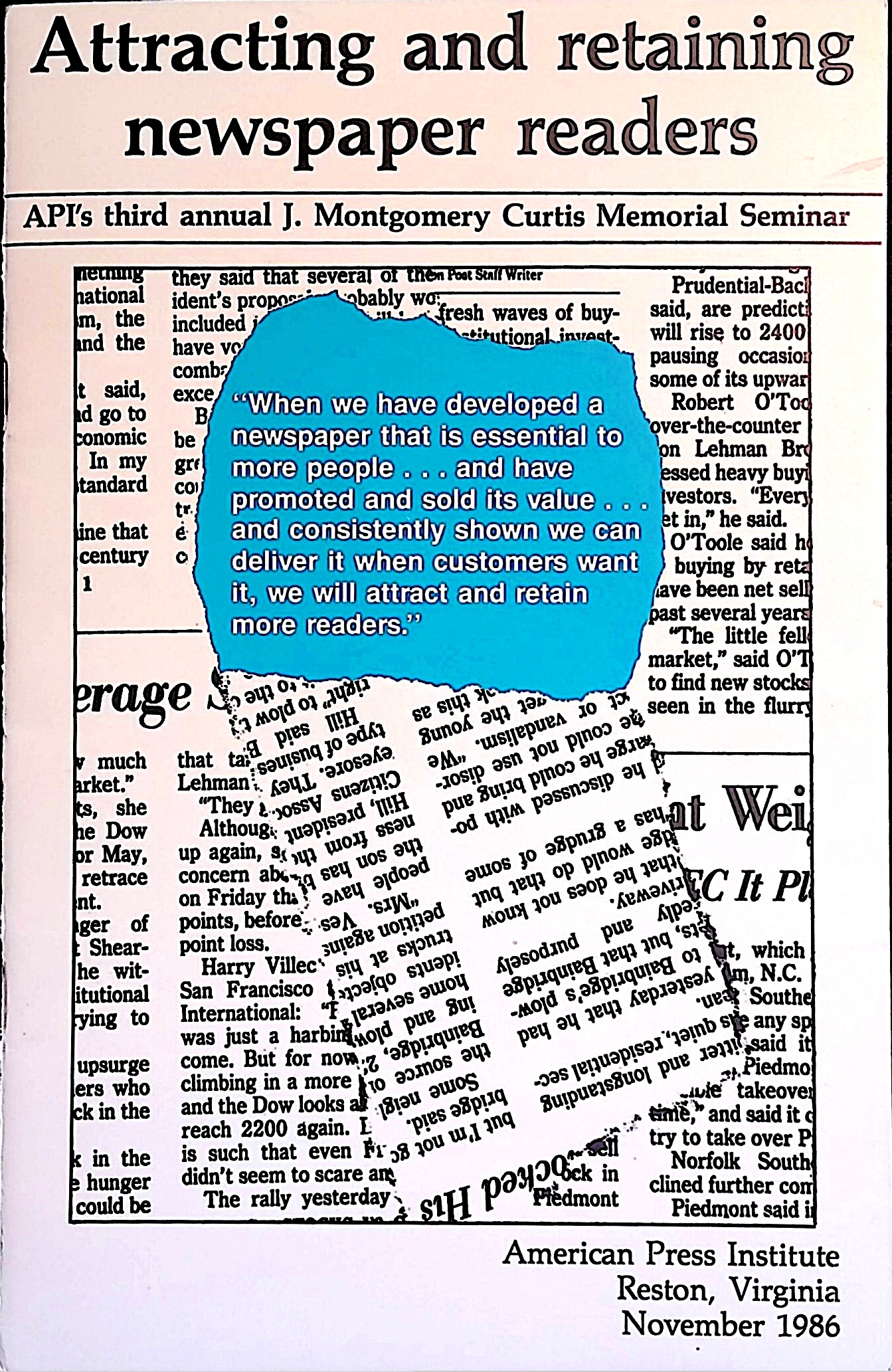Attracting and Retaining Readers, 1986
For as long as I was in the newspaper industry, I’ve heard the refrain “we need to attract new and retain our current readers.”
Mostly, in the “olden days” that meant a new promotion or some kind of circulation push [cut the prices and retain them when the full-cost renewal hits].
The American Press Institute held a seminar in November 1986 and invited 21 editors, publishers, circulation directors and other executives to focus on:
• Meeting the needs of a changing newspaper audience.
• Increasing household penetration.
• Reader retention.
• Fresh methods for marketing and promoting the newspaper.
While the report on the conference focus on aspects of the newspaper industry that are revenue driven — advertising and circulation– there was some discussion about improving the overall editorial product. From the section titled “Relating to Readers,” Chris Anderson, editor of the Orange Country Register urged an upgrade of the quality of content:
“Quality sells newspapers. But it doesn’t come easily, and it doesn’t come free.” It is increasingly apparent, he said, that newspapers must make long-term investments in editorial content that arc not immediately cost-justifiable – but will have long-term benefit. He listed these as primary ingredients in a newspaper’s quality:
- We are specific to our own set of readers. We “belong” to them.
- There are things for lots of different readers. Our readership is a coalition of special-interest groups
- We make things easy to find and to read. Consistency and packaging arc especially important.
- A good newspaper is compelling and personal. “Readers have no obligation to take the rubber band off. It’s easier to watch TV.”
- We involve our readers, and help them tell their stories.
- Professionalism is painstaking attention to detail.
There was one page on the potential of computers, at least when it comes to circulation, to help newspapers understand their market and where their subscribers live.
The booklet about the conference has recommendations are well past their “sell by” date. The marketplace has upended advertising and circulation revenue streams. And that left many newspaper readers, or the remaining newspaper readers, high and dry.
Here’s a summary generated by AI about the seminar
Attracting and Retaining Readers: What the Industry Was Saying in 1986
📅 American Press Institute Curtis Seminar, November 1986
📍 Reston, Virginia
In the fall of 1986, a select group of newspaper editors, designers, and media scholars gathered at the American Press Institute for the Curtis Seminar on Attracting and Retaining Readers. The purpose: to examine declining readership trends and explore strategies that might reverse them. Though digital disruption had not yet arrived, there was already a strong sense that change was needed.
The seminar materials read like a cross between a strategic workshop and a newsroom therapy session. Titles such as “Understanding Reader Behavior,” “Packaging the Paper,” and “Reversing the Downward Trend” reflect a growing awareness that traditional newspaper practices were losing traction with modern audiences. Participants tackled tough questions about design, content hierarchy, service journalism, and how to make newspapers more relevant—especially to younger readers and women, demographics that were already disengaging.
There’s a notable urgency in the recommendations: trim excess verbiage, lead with utility, give readers navigational tools, and design with intention. The themes of clarity, connection, and relevance emerged again and again, with a shared belief that newspapers needed to better align with the everyday concerns of readers—not just editorial priorities.
What’s especially striking is the vocabulary of experimentation and evolution—terms that feel contemporary but were clearly part of the industry’s discourse nearly 40 years ago. Participants acknowledged that reader expectations had changed, and that the paper’s design, structure, and tone needed to evolve as well.
The Curtis Seminar offers a revealing snapshot of a profession in self-reflection. It shows that even before the rise of the internet, journalism leaders were grappling with how to hold onto their audience, adapt to shifting habits, and make newspapers more useful, relevant, and readable. Many of those questions remain just as pressing today.

 api attracting readers 1986_2
!!!!!!!!!!!
api attracting readers 1986_2
!!!!!!!!!!!Related Items
No related items.